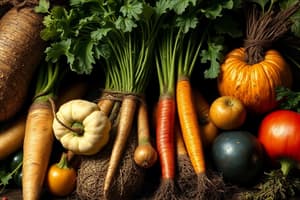Podcast
Questions and Answers
Which type of vegetable grows underground?
Which type of vegetable grows underground?
- Root vegetables (correct)
- Leafy vegetables
- Stem vegetables
- Fruit vegetables
What is a characteristic of vegetables in terms of nutrition?
What is a characteristic of vegetables in terms of nutrition?
- High in calories and low in fiber
- Low in vitamins and high in fat
- Low in calories and high in fiber (correct)
- Rich in protein and low in antioxidants
What is the best way to cook vegetables to retain their nutrients and color?
What is the best way to cook vegetables to retain their nutrients and color?
- Frying and baking
- Steaming and boiling (correct)
- Roasting and grilling
- Stir-frying and sautéing
Which type of vegetable is often used in salads and smoothies?
Which type of vegetable is often used in salads and smoothies?
What is a common use for Allium vegetables?
What is a common use for Allium vegetables?
Why is washing and cleaning vegetables important?
Why is washing and cleaning vegetables important?
Study Notes
Classification of Vegetables
By Growth Habit
- Root vegetables: grow underground (e.g., carrots, beets)
- Stem vegetables: grow above ground on a stem (e.g., celery, asparagus)
- Leafy vegetables: grow on a stem with edible leaves (e.g., lettuce, spinach)
- Fruit vegetables: fruit of a plant used as a vegetable (e.g., tomatoes, cucumbers)
- Allium vegetables: bulbs or stems with a strong flavor (e.g., onions, garlic)
Nutritional Value of Vegetables
- Rich in vitamins, minerals, and antioxidants
- Low in calories and high in fiber
- Supports healthy digestion, immune system, and weight management
- Can help reduce risk of chronic diseases (e.g., heart disease, diabetes)
Preparation and Cooking Methods
- Washing and cleaning: important to remove dirt, bacteria, and pesticides
- Steaming and boiling: retain nutrients and color
- Roasting and grilling: enhance flavor and texture
- Stir-frying and sautéing: quick cooking methods for tender vegetables
Common Vegetables and Their Uses
- Leafy greens (e.g., spinach, kale): salads, smoothies, sautéed sides
- Cruciferous vegetables (e.g., broccoli, cauliflower): steamed, roasted, or sautéed
- Root vegetables (e.g., carrots, beets): roasted, mashed, or pickled
- Allium vegetables (e.g., onions, garlic): add flavor to various dishes
Classification of Vegetables
- Vegetables can be classified into five categories based on their growth habit: root, stem, leafy, fruit, and allium vegetables
- Root vegetables grow underground, examples include carrots and beets
- Stem vegetables grow above ground on a stem, examples include celery and asparagus
- Leafy vegetables grow on a stem with edible leaves, examples include lettuce and spinach
- Fruit vegetables are the fruit of a plant used as a vegetable, examples include tomatoes and cucumbers
- Allium vegetables are bulbs or stems with a strong flavor, examples include onions and garlic
Nutritional Value of Vegetables
- Vegetables are rich in vitamins, minerals, and antioxidants
- They are low in calories and high in fiber, supporting healthy digestion
- They have a high satiety value, supporting healthy weight management
- Vegetables have been shown to reduce the risk of chronic diseases such as heart disease and diabetes
Preparation and Cooking Methods
- It is essential to wash and clean vegetables to remove dirt, bacteria, and pesticides
- Steaming and boiling are cooking methods that help retain nutrients and color
- Roasting and grilling are cooking methods that enhance flavor and texture
- Stir-frying and sautéing are quick cooking methods suitable for tender vegetables
Common Vegetables and Their Uses
- Leafy greens such as spinach and kale are suitable for salads, smoothies, and sautéed sides
- Cruciferous vegetables such as broccoli and cauliflower can be steamed, roasted, or sautéed
- Root vegetables such as carrots and beets can be roasted, mashed, or pickled
- Allium vegetables such as onions and garlic add flavor to various dishes
Studying That Suits You
Use AI to generate personalized quizzes and flashcards to suit your learning preferences.
Description
Learn about the different types of vegetables classified by growth habit and explore their nutritional value. Discover the richness of vitamins, minerals, and more in various vegetables.




